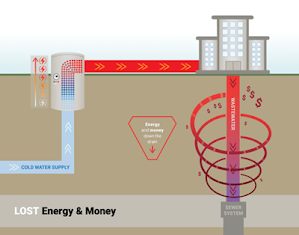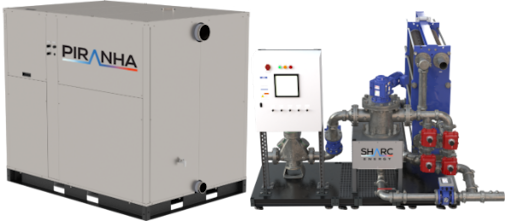The Climate Crisis is scary, making the future seem uncertain,
but times like this is when we sometimes bring out the best parts of ourselves.
I’m talking about the inventiveness, and creativity that we share as a species,
our ability to find the most brilliant solutions to our most dire problems, in
the most unexpected of places. I was attending a presentation hosted by Cascadia Cleantech Alliance when I
learned about a company, that was tapping into what was to me the most
unexpected source of renewable energy.
SHARC ENERGY, located in Port Coquitlam British Columbia, is a
company that builds wastewater energy recovery systems. When we use water in
everyday life, we don’t tend to think about it once it has gone down the drain,
so we often don’t realize how much useable heat we’re just wasting. When we use
hot water to wash our hands, take showers, do our laundry, etc. we turn our
sewers into reservoirs of forgotten thermal energy lying dormant beneath our
feet.
Surprisingly the energy that’s discarded into our wastewater systems is actually significant. If you look at the infographic by SHARC Energy, conventional sewer systems simply take this heated wastewater and send it into the sewers to be treated and subsequently, released back into the environment, but wastewater systems using SHARC Energy capture that heat from wastewater using heat pumps to preheat fresh water that is destined for the building’s hot water tanks (1).
This process of wastewater energy recovery offers a surprising
number of benefits in terms of lower costs, lower greenhouse gas emissions, less
freshwater wasted, and lower environmental impact. Using wastewater energy
recovery reduces the amount of natural gas a building needs to meet its heating
requirements. For example, SHARC Energy claims that they have seen a 44%
reduction in energy usage in their systems at their 3200 Bluff Project in
Boulder Colorado(2.). The process also reduces the
amount of freshwater needed by eliminating the need for cooling towers because energy
can also be rejected into the wastewater energy system as well as recovered (1).
Another interesting benefit of wastewater energy recovery is
that the process cools the wastewater, eventually returning to the environment
after treatment. This is important for 2 reasons. Firstly, increasing the
temperature in aquatic ecosystems can have negative impacts on
temperature-sensitive species (3.),
and secondly, dumping high-temperature water into our oceans exhausts our
oceans’ ability to regulate our climate. The explanation for this requires a
little bit of background first.
When we think of climate change, we think of how the increase
in greenhouse gasses trap more heat in the atmosphere, but the atmosphere’s
mass pales in comparison with the mass of our oceans. This means that the
oceans have a massive capacity for heat, as well as a massive effect on our climate
(4.). Because
the oceans have so much mass, they also have a high heat inertia, which means
that the climate will keep warming for a while even if we cut all greenhouse
gas emissions. In the same way, a roast turkey keeps cooking when you let it
rest after pulling it out of the oven, our oceans will keep exuding heat for a while
because it takes a long time to cool something so massive. So it’s important to
make sure that our treated wastewater is cooled before it’s released back into
the oceans.
The SHARC and The PIRAHNA
SHARC Energy has two product lines. The SHARC series for large-scale wastewater treatment projects such as “district energy, large commercial and Industrial use” (5.). And the second product line is the PIRAHNA series for smaller-scale projects such as “apartment complexes, hotels, and commercial use” (6). According to the PIRAHNA brochure, the scale the PIRAHNA addresses is on the order of 50–350-unit apartments.
There are 3 ways to get involved in SHARC. Becoming a
customer, becoming an investor, and finally, an option with a low barrier to
entry, interning at SHARC Energy.
Anyone interested in purchasing SHARC systems can reach out to
them at contact.sharcenergy.com
Anyone interested in becoming an investor should check out the
following investor.sharcenergy.com
SHARC doesn’t publicly advertise their internship programs so
all inquiries should be sent through to their contact us page.
Feel free to reach out to SHARC Energy with any questions you
have on the Terrestrious
Community Discord!
Final Thoughts
Our journey exploring wastewater energy recovery really
highlights for me the opportunities we are faced with at this very moment in
our history. Yes, we are in the middle of a climate crisis, but it is this
crisis that is inspiring our very human ability to search for new solutions.
Maybe you knew about wastewater energy recovery before reading this article and
kudos to you, but I and many other are outsiders to the world of cleantech. Going
through this process of building Terrestrious, and reaching out to companies
like SHARC Energy on the frontlines of the climate crisis, I get to explore firsthand
how the most unexpected solutions. like energy in the sewers beneath our feet
is harnessed for the good of humanity. I don’t know about you, but it’s
solutions like these that make me look hopefully toward the future.
To learn more be sure to check out SHARC Energy’s customer highlights, and
their work to combine their systems with geothermal
energy!











